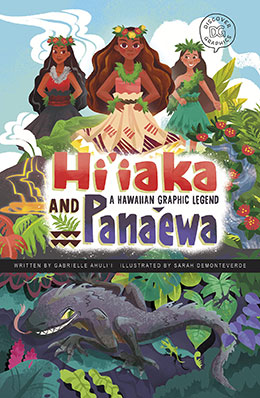
When I was a kid, I had a set of books called Great Illustrated Classics. They were fat volumes full of stories embellished with black and white drawings. The scariest tales were from Greek and Roman mythology where the hero battled bad guys and won (most of the time.)
Even in school, the myths we read were limited to Greek and Roman gods with names like Zeus, Athena, Poseidon and Mars.
But where were the colorful picture books about Pele, Maui, Kaʻahupahau, Kamapuaʻa, the menehune? There weren’t any, not in the kidlit section of the library or in any of the illustrated classics that lined my childhood bookshelf.
The message native kids like me got loud and clear was that those Greeks and Romans were the classic heroes, the only heroes worth learning about.
Thankfully, times are changing. More Native Hawaiian authors and artists are revisiting and retelling our traditional stories for today’s young audiences.
The latest is a graphic novel, Hiʻiaka and Panaʻewa, by Native Hawaiian author Gabrielle Ahuliʻi. Intended for the picture book crowd, ages 4 – 8, and their grown-ups, this book is the perfect introduction to Hawaiian myths for the youngest readers.
The story, as described in the summary, is:
Hiʻiaka wants to make the forests of Hawaiʻi safe for people. But sheʻll have to battle an evil lizard named Panaʻewa and his army to do it. With a little help from her sister, her friend, and some special powers, sheʻs ready for a great battle.”
This is a story of friendship and sisterhood. Faced with the task of keeping the forest safe for the people, Hiʻiaka, accompanied by her friend Wahineʻōmaʻo, must decide how to challenge the fearsome guardian mo’o, Panaʻewa.
In one of my favorite scenes, Hiʻiaka seeks strength by looking up at the stars and remembering the courage it took for her ancestors to brave the vast Pacific Ocean to settle in Hawaiʻi. This simple panel conveys such emotion in a deeply Hawaiian way.
The small cast of characters are totally likeable. They experience some fears and doubts, but ultimately they find strength from within and from each other. The battle with Panaʻewa is scary, but the scene is not too intense for young readers.
As expected in a children’s story, the heroes prevail, and the end is hopeful. The last panel neatly ties up the story by reflecting the very first panel of the island below and the manuokū flying above.
I appreciate that the story is presented as a short (32 page) graphic novel. The format with its thoughtful word choice and poetic devices is perfect for its intended audience of beginning readers but also as a read aloud.
The illustrations are intentionally sparse. Kids can easily get overwhelmed in traditional comic book style, but in this book, frantic, overdrawn panels are avoided. Instead, the colorful, picture book-like illustrations convey both story and emotion appropriate for the intended age group.
More than anything, I love the author’s authentic voice. Everything, from imagery – especially Pele’s skirt and lei, the voyaging canoe, the manuokū seabird, the moʻo – to the selected words in ʻōlelo Hawaiʻi feels pono. For traditionalists in my community, this story of Pele and Hiʻiaka is respectful.
The bookʻs back matter consists of helpful resources, including writing prompts, discussion questions, and a short glossary.
In her author’s note, Ahuliʻi writes, “I hope our ancestors look on my telling with pride.”
I am sure they are.
Hiʻiaka and Panaewa, A Hawaiian Graphic Legend
Written by Gabrielle Ahuliʻi. Illustrated by Sarah Demonteverde
Published by Picture Window Books, 2023
ISBN: 9781484672907
Suggested for ages 4 – 8
Learn about the author in our talk story interview with Gabrielle Ahuliʻi. To look up the definitions of the Hawaiian terms used in this post, please visit Nā Puke Wehewehe.




2 thoughts on “Book Review: Hiʻiaka and Panaʻewa, a Graphic Novel by Gabrielle Ahuliʻi”
I enjoy reading Gabrielle’s comments on the importance of our Native hawaiian mythology and heroes and how she is able to share through her writing
Mahalo, Luis.